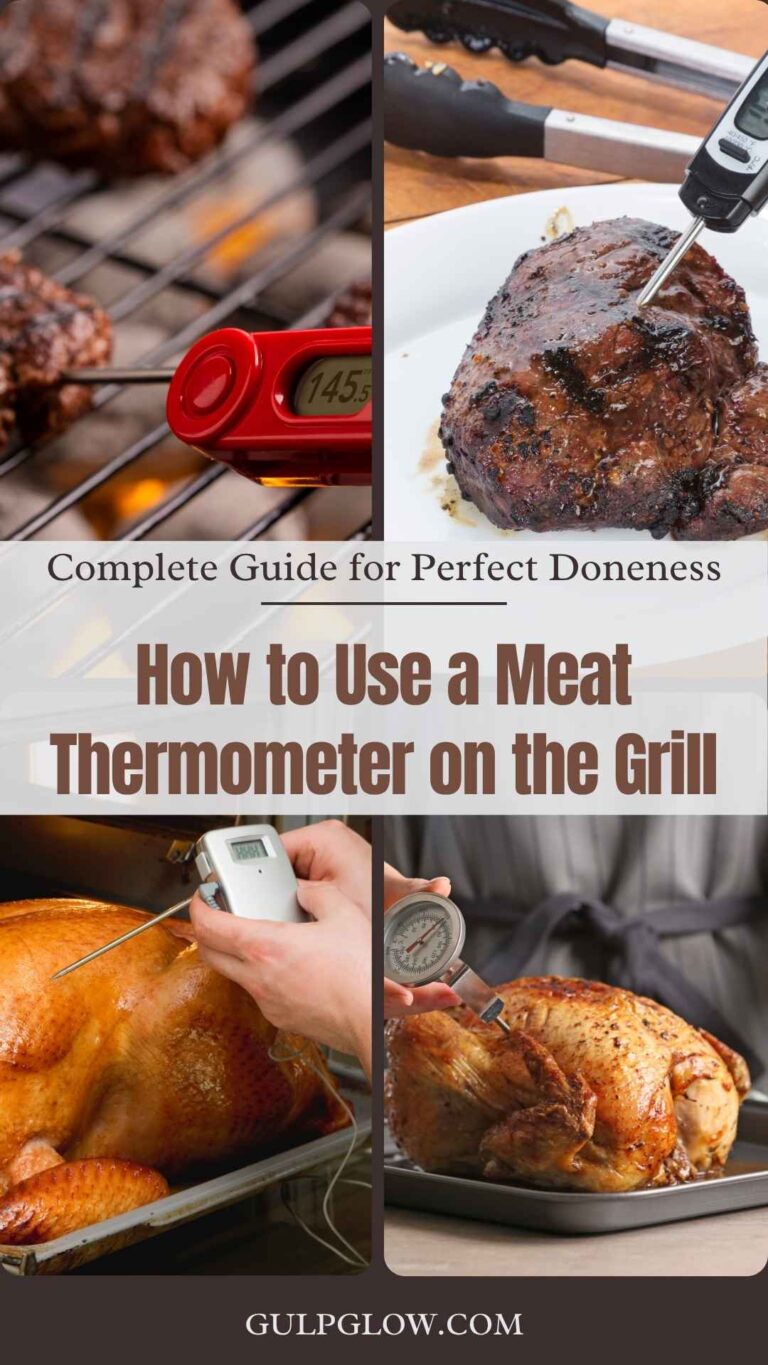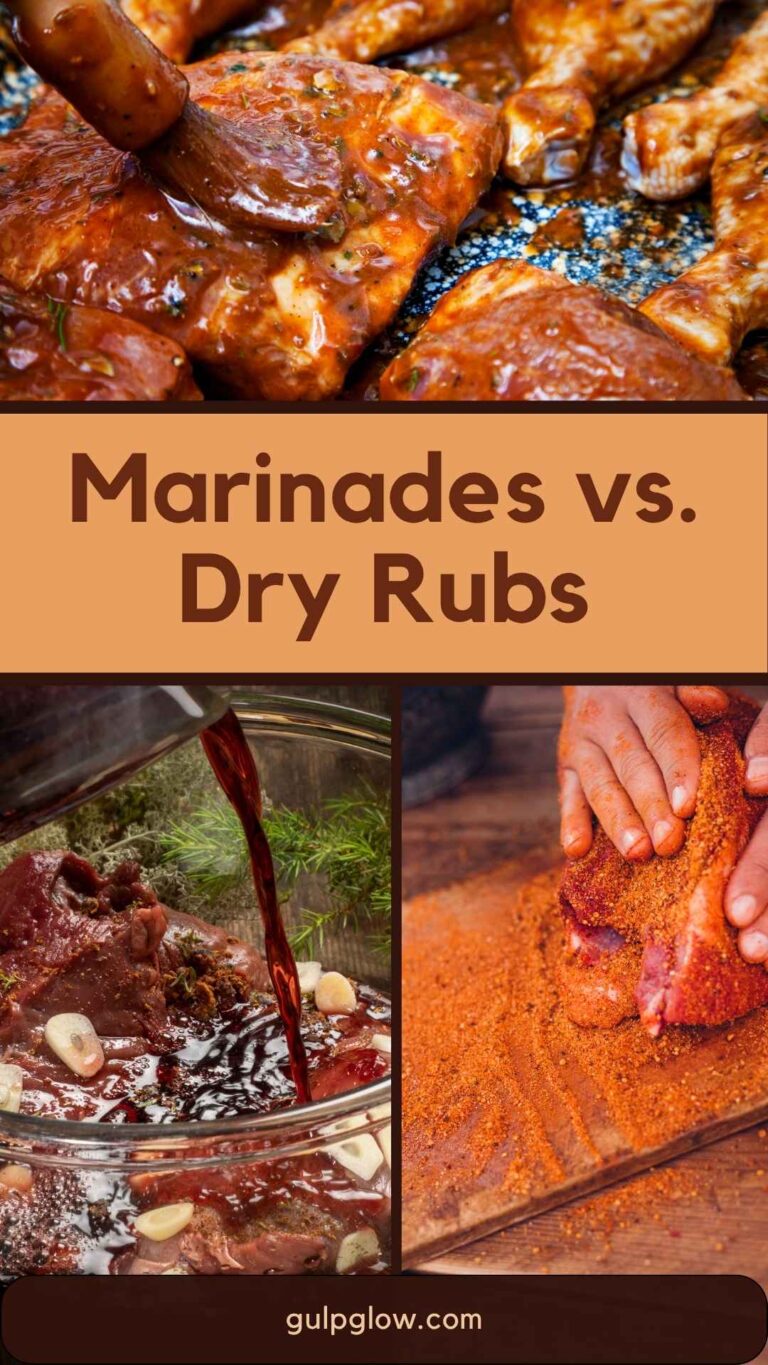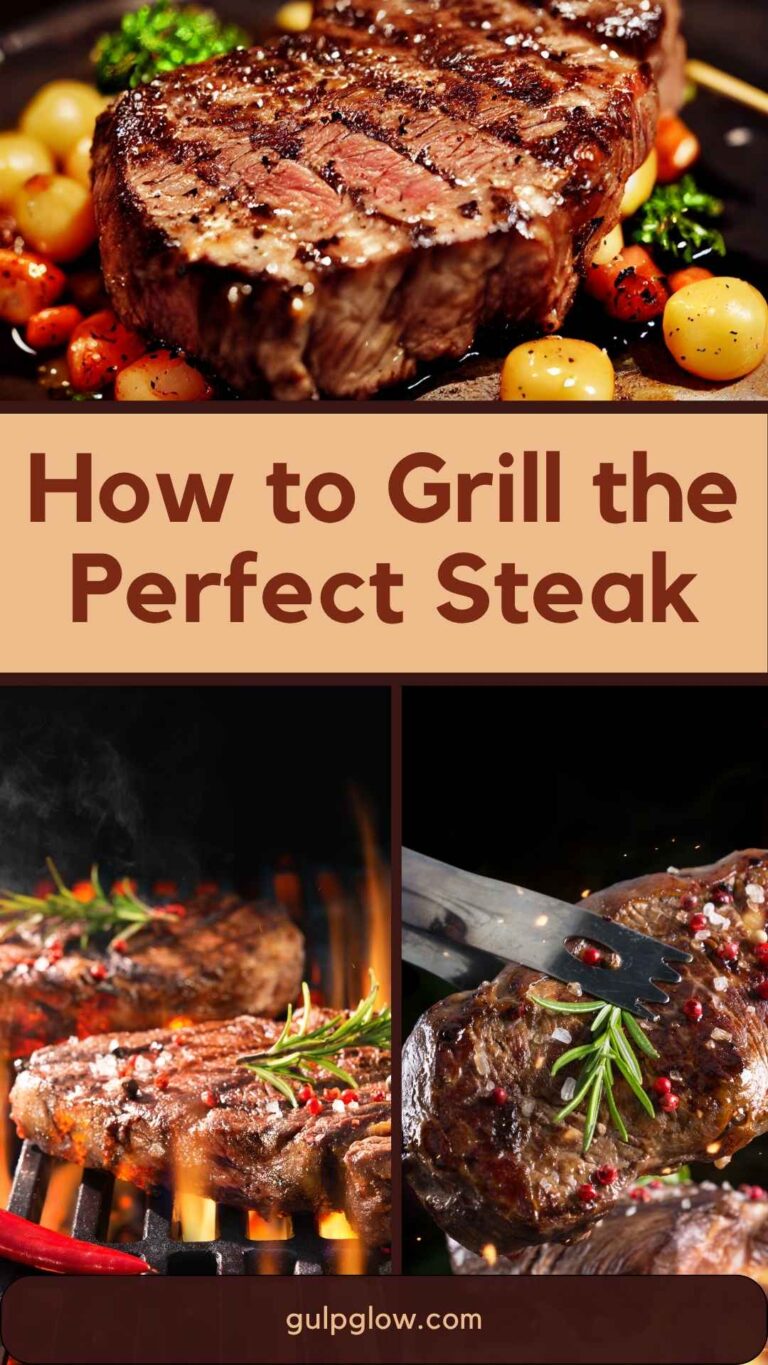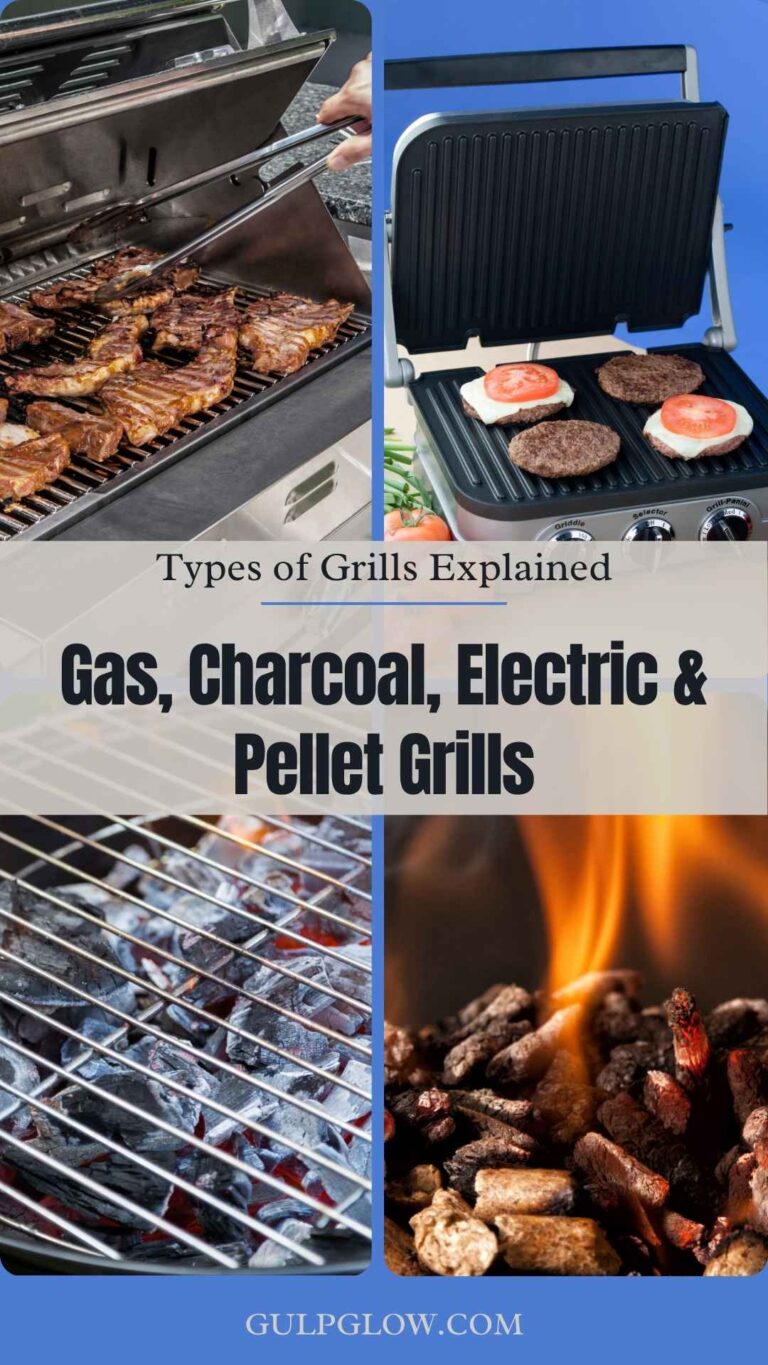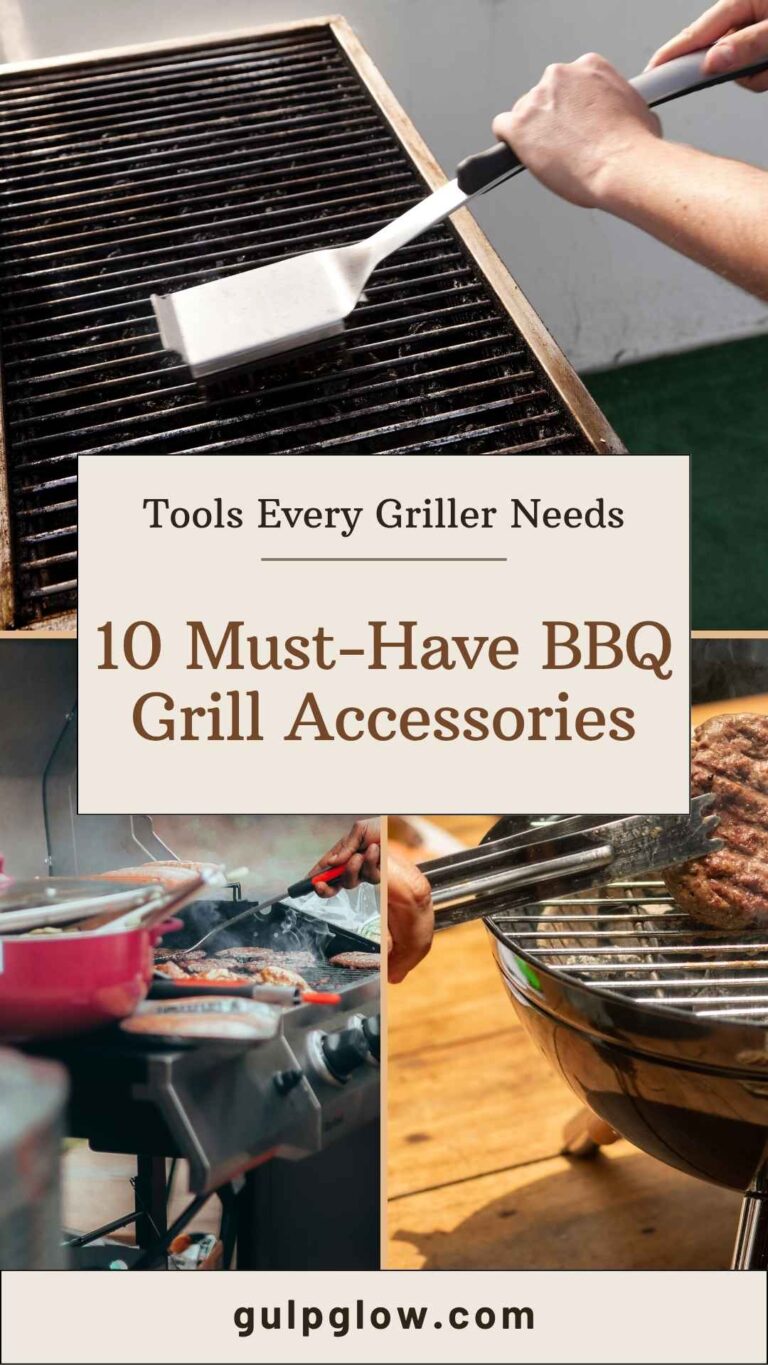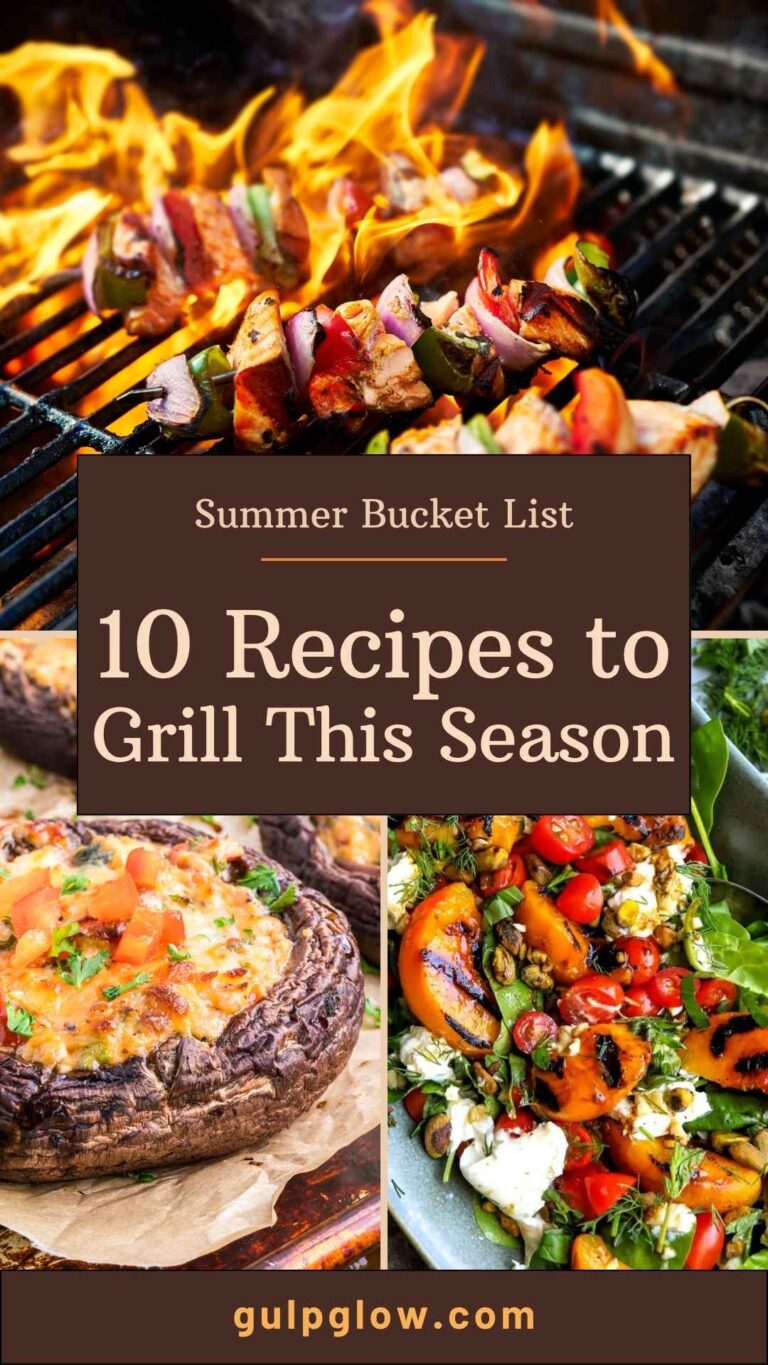Grilling vs. Barbecuing: What’s the Difference?
If you’ve ever stood by a backyard grill at a summer cookout, chances are you’ve heard the terms “grilling” and “barbecuing” tossed around—sometimes in the same breath, sometimes with passionate debate. For many, these words seem interchangeable. But ask any true pitmaster or grilling enthusiast, and you’ll quickly discover there’s a world of difference between the two.

Understanding what sets grilling apart from barbecuing isn’t just a matter of culinary trivia. It can mean the difference between a perfectly seared steak and a melt-in-your-mouth rack of ribs. Each method brings its own flavor, texture, and style to the table—and knowing which to use (and when) can elevate your outdoor cooking game to the next level.
In this article, we’ll clear up the confusion, break down the core techniques, and explore the signature tastes that make grilling and barbecuing unique. By the end, you’ll know exactly which method to reach for the next time you fire up the grill—no more guesswork, just delicious results every time.
Heat Levels & Cooking Time
One of the most fundamental differences between grilling and barbecue lies in how heat is used. This single factor not only affects the duration of cooking but also dramatically alters the flavor, texture, and appearance of food.
🔥 Grilling: High Heat, Fast Results
Grilling relies on direct, intense heat—typically between 350°F and 500°F (175°C–260°C) or even higher. Food is placed directly over the heat source, which could be burning charcoal, a gas flame, or electric coils. The goal is to sear the exterior quickly while keeping the interior juicy.

This method is perfect for foods that cook in a short time:
- Steaks and burgers
- Chicken breasts and drumsticks
- Fish and shellfish
- Vegetables like corn, peppers, and zucchini
Cooking time usually ranges from 5 to 20 minutes, depending on the thickness and type of food. The key is high heat and speed.
🪵 BBQ: Low and Slow
In contrast, barbecue uses low, indirect heat, generally between 200°F and 300°F (93°C–150°C). This method cooks food slowly over several hours, often using wood or charcoal to produce smoke, which infuses the meat with rich flavor.
Common BBQ cook times:
| Food Type | Typical BBQ Time |
|---|---|
| Pork Shoulder | 8–12 hours |
| Beef Brisket | 10–18 hours |
| Ribs (Pork/Beef) | 4–6 hours |
| Whole Chicken/Turkey | 3–5 hours |
This “low and slow” philosophy allows collagen and fat in tough cuts to break down gradually, resulting in meat that’s tender, juicy, and deeply flavored.
Read Also: Summer Grilling Recipes You Must Try!
Equipment & Setup
Choosing the right equipment is critical for executing either grilling or BBQ effectively. While they may look similar, the setup and usage of each method differ significantly.
🔧 Grills: Direct Heat Powerhouses
Grills are designed for direct-heat cooking, meaning the flame or heat source is positioned directly beneath the food. The lid is often left open during grilling to maintain high temperatures and allow for quick searing.
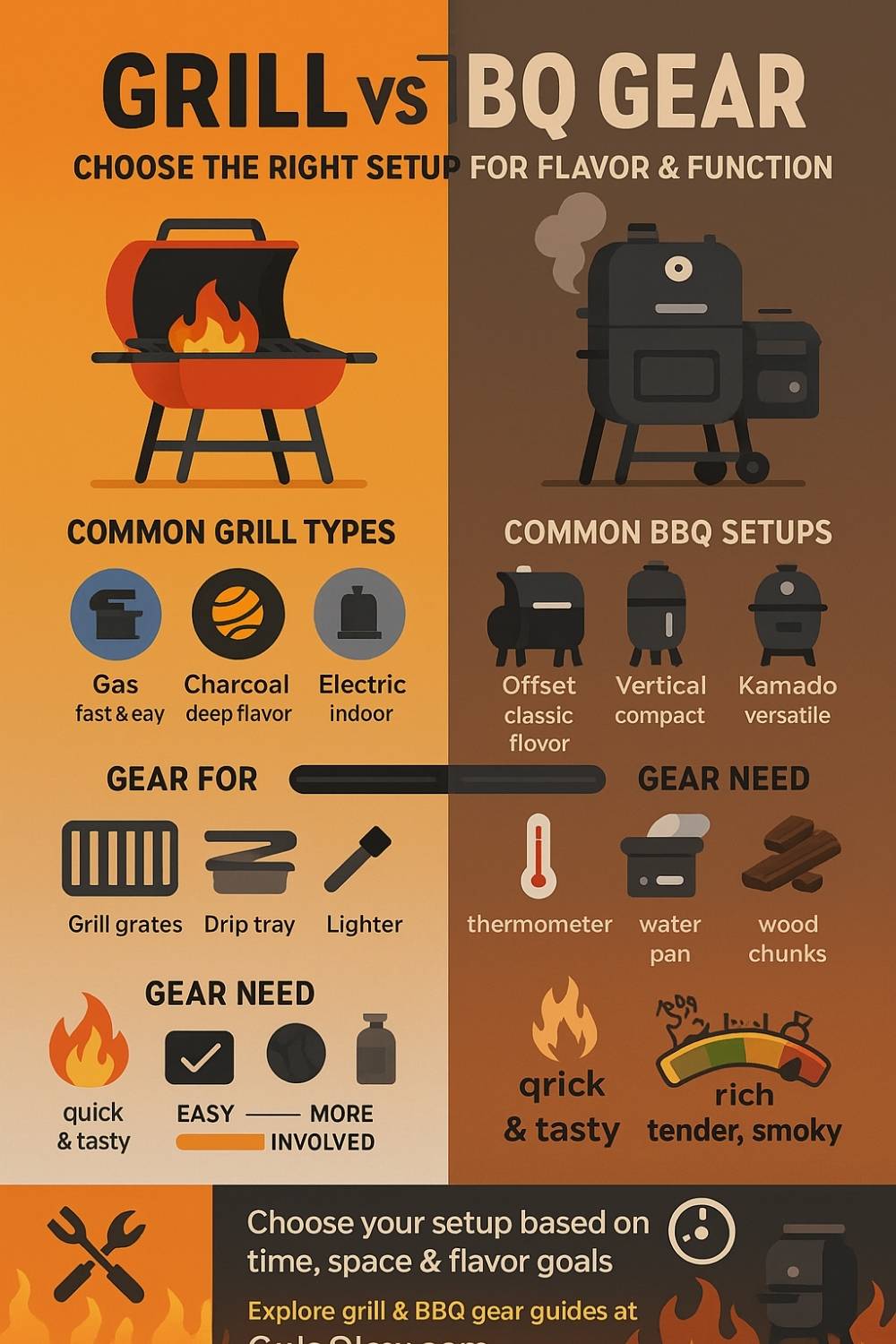
Common types of grills:
- Gas Grills: Easy to use, fast heating, good for weeknight meals.
- Charcoal Grills: Deeper flavor, more heat control challenges.
- Electric Grills: Indoor-friendly but less authentic flavor.
Grilling setups are usually straightforward, with minimal accessories beyond grates, a drip tray, and a grease catcher.
🏕️ Smokers and BBQ Pits: The Low-Heat Masters
Barbecue setups are designed for indirect heat cooking, often requiring a bit more space and patience. The heat source (wood, charcoal, or pellets) is placed to the side or beneath a water/drip pan. The lid or chamber remains closed to trap heat and circulate smoke.
Types of BBQ cookers:
- Offset Smokers: Firebox on the side; smoke travels across the chamber.
- Vertical Water Smokers: Compact, with water pans to regulate heat.
- Pellet Smokers: Wood pellets auto-fed for consistent heat and smoke.
- Kamado Grills (e.g., Big Green Egg): Versatile for both grilling and BBQ.
These setups require more gear and maintenance but reward you with superior flavor and tenderness.
Fuel Types & Their Influence
The type of fuel you use—whether it’s gas, charcoal, wood, or pellets—not only determines cooking temperature but also impacts the flavor and complexity of your final dish.
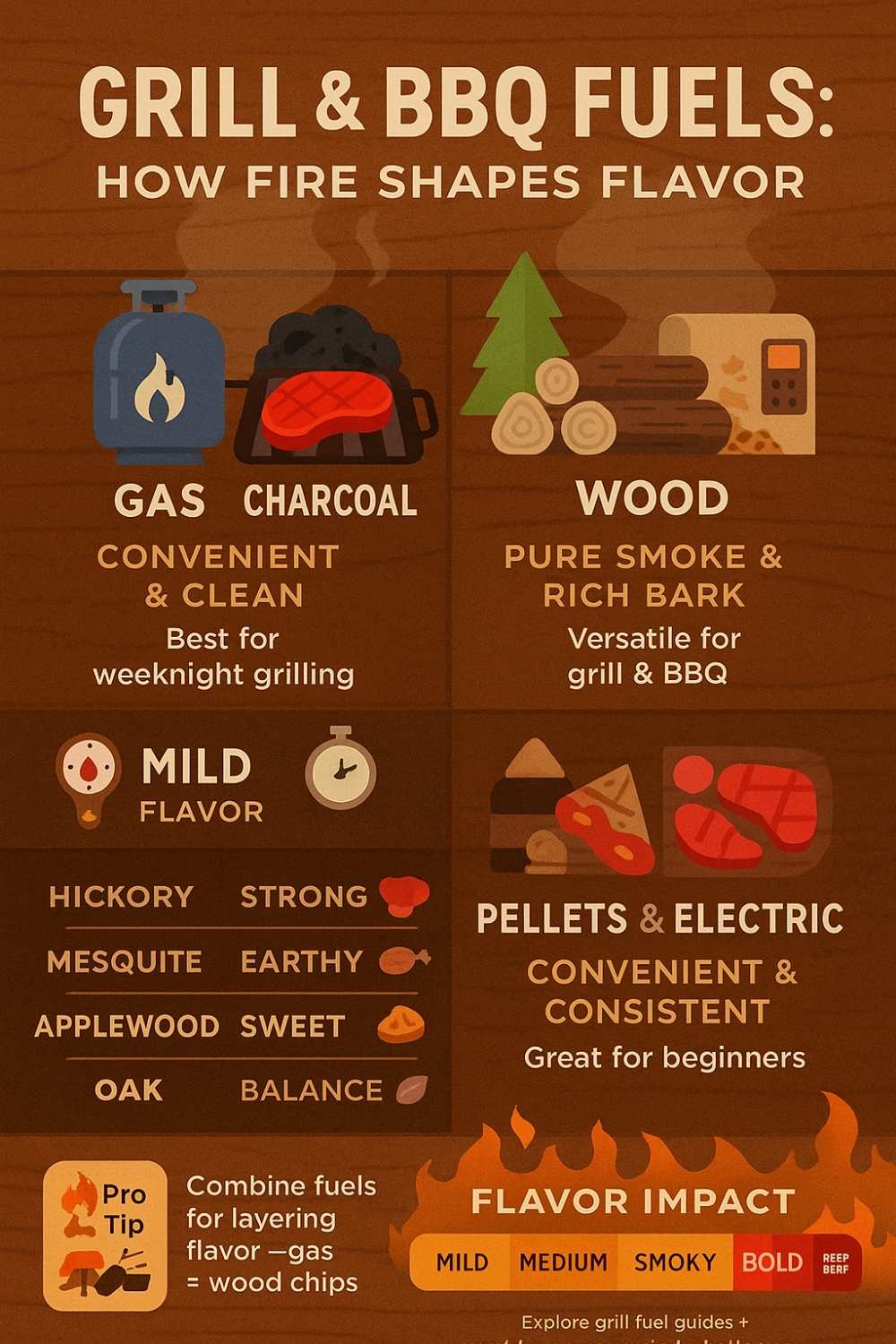
⛽ Gas: Convenience with a Trade-off
Gas grills are ideal for grilling because they heat up quickly and allow precise temperature control. However, they lack the smoky depth that charcoal or wood provide, making them less suitable for authentic barbecue.
Best for: Quick meals, consistent grilling, ease of use
Flavor: Mild, no smoke unless using smoker boxes
🔥 Charcoal: The Flavor Booster
Charcoal burns hotter than gas and imparts a rich, smoky taste, even when grilling. It’s also more versatile—by adjusting airflow and coal placement, you can create direct or indirect heat zones suitable for both grilling and BBQ.
Best for: Traditional grilling and DIY BBQ setups
Flavor: Bold, authentic char and smoke
🌲 Wood: The Soul of True BBQ
Hardwoods like hickory, mesquite, applewood, and oak are key to true BBQ flavor. Used in chunks, chips, or logs, wood adds distinctive smoke profiles to different meats.
| Wood Type | Flavor Profile | Ideal For |
|---|---|---|
| Hickory | Strong, smoky | Ribs, pork shoulder |
| Mesquite | Earthy, bold | Brisket, beef |
| Applewood | Sweet, mild | Poultry, pork, seafood |
| Oak | Medium, balanced | Brisket, sausage, lamb |
🪵 Pellets & Electric: Modern Options
Pellet grills combine the convenience of gas with the flavor of wood. Electric smokers are plug-and-play solutions ideal for beginners, though they sometimes lack a traditional smoke ring or deep bark formation.
Best for: Set-it-and-forget-it BBQ
Flavor: Variable, depending on pellet quality and electric model
Tools & Accessories
While heat and fuel are fundamental, having the right tools is what turns a good cookout into a great one. Grilling and BBQ each benefit from their own specialized gear, and knowing what to use—and when—can improve both safety and results.

🍴 Essential Grilling Tools
Grilling involves high temperatures and fast cooking, so tools need to be durable and responsive.
- Long-Handled Tongs: For flipping meat without burning your hands.
- Spatula: Ideal for burgers, fish, and delicate items.
- Grill Brush: Crucial for cleaning grates between sessions.
- Basting Brush: For applying sauces or oil during grilling.
- Meat Thermometer: Ensures meats are cooked to safe internal temperatures.
Optional but helpful:
- Grill basket for vegetables or fish
- Chimney starter for charcoal ignition
- Grill light for nighttime cooking
🔧 BBQ Tools & Accessories
Barbecue is about precision, patience, and moisture control. These tools help you maintain consistency over long hours.
- Digital Probe Thermometer: For monitoring meat and smoker temps simultaneously.
- Meat Claws or Shredders: Essential for pulled pork or brisket.
- Water Pans: Keep the cooking chamber humid.
- Wood Chip Box: Holds soaked chips for added smoke in gas grills.
- Heat Deflectors/Drip Pans: Prevent flare-ups and stabilize temp.
Other must-haves:
- Fireproof gloves
- Spray bottle (with apple cider vinegar or water)
- Aluminum foil and butcher paper for wrapping meats during long cooks
Investing in the right tools pays off not only in performance but also in safety and flavor control.
Cuts of Meat & Best Use Cases
What you cook matters just as much as how you cook it. Certain meats (and even vegetables) perform better with specific methods due to their texture, fat content, and connective tissue.
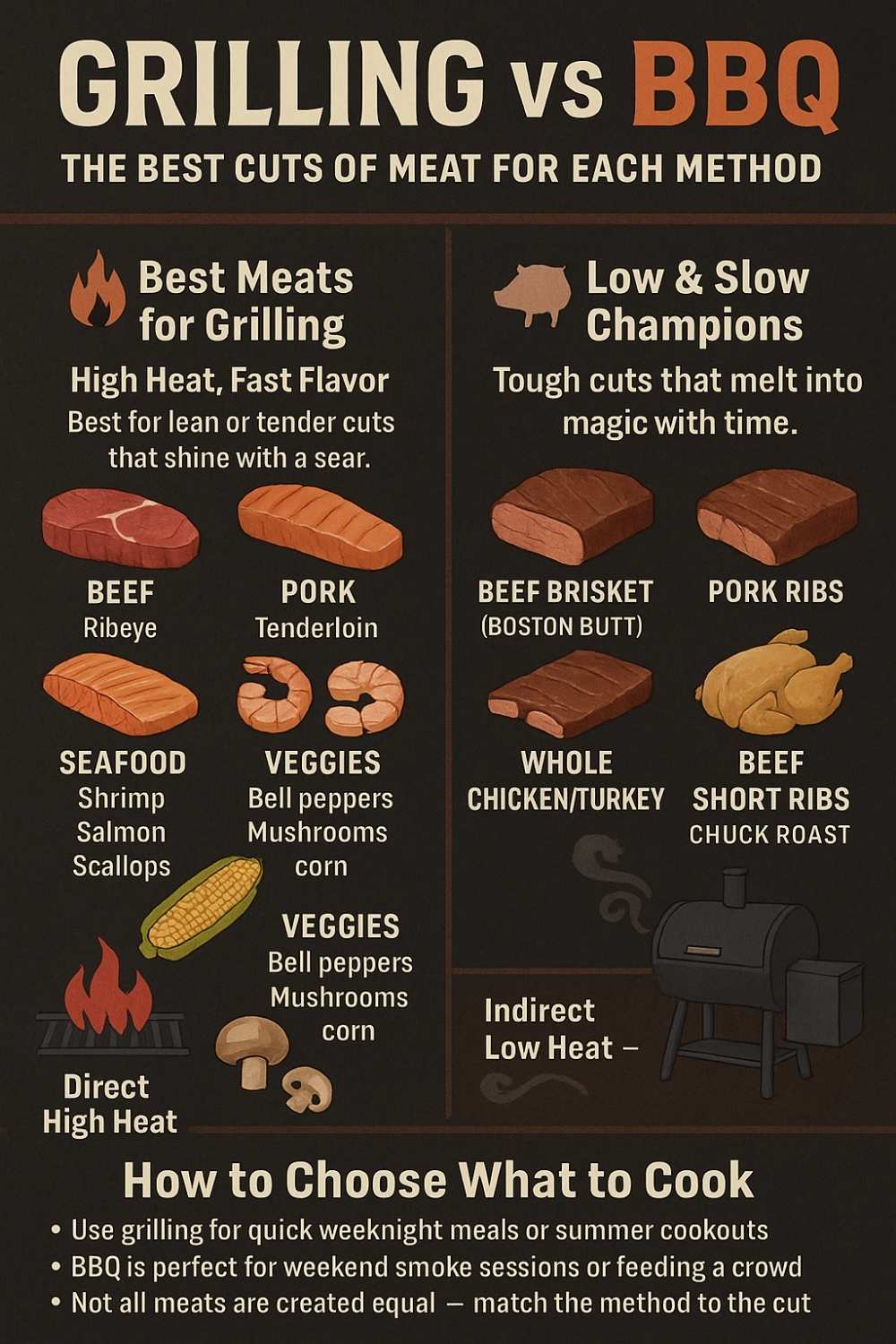
🥩 Best Meats for Grilling
Grilling suits tender cuts that benefit from high heat and quick cooking. These cuts are typically lean or moderately marbled.
Top choices:
- Beef: Ribeye, sirloin, filet mignon, burgers
- Pork: Chops, tenderloin
- Chicken: Breasts, thighs, skewers
- Seafood: Shrimp, salmon, scallops
- Vegetables: Bell peppers, mushrooms, corn on the cob
These foods don’t need hours of smoke—they shine with a crisp sear and slight char.
🐖 Best Meats for BBQ
BBQ is designed for tough, collagen-rich cuts that transform through long, slow cooking. These cuts are often fatty, thick, or bone-in.
Top BBQ choices:
- Pork Shoulder (Boston Butt): Pulled pork classic
- Beef Brisket: A BBQ staple that becomes tender after hours
- Pork Ribs: Baby back or spare ribs develop bark and depth
- Whole Chicken/Turkey: Moist and smoky when cooked low and slow
- Beef Short Ribs or Chuck Roast: Excellent for smoke absorption
The prolonged exposure to indirect heat breaks down connective tissues, resulting in melt-in-your-mouth texture and deep flavor.
Flavor Profiles & Seasoning
Flavor is where grilling and BBQ truly part ways. While both offer delicious results, the types of seasonings, application methods, and final taste profiles differ significantly.
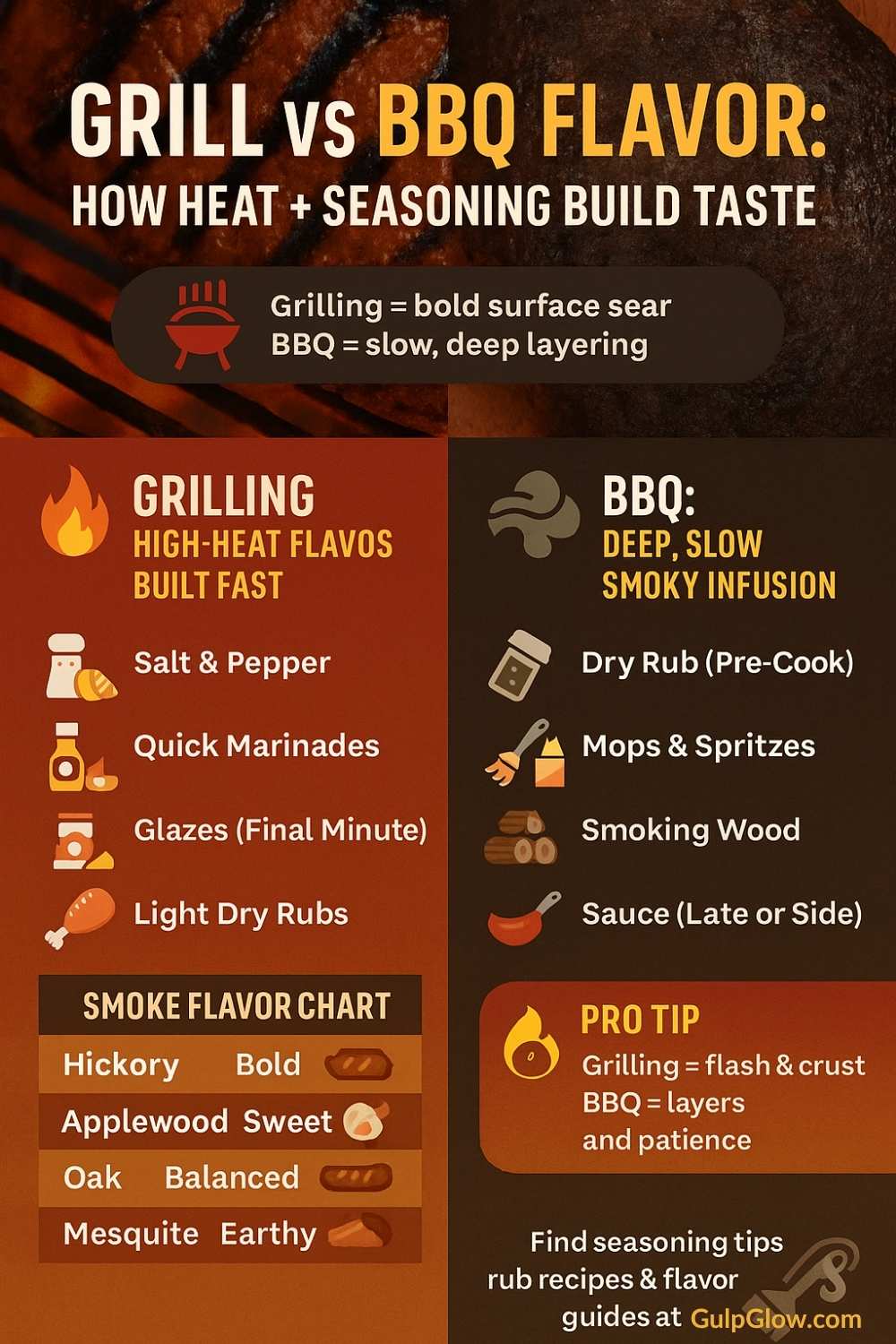
🧂 Grilling: Simple, Sear-Forward Flavor
Grilling is all about the Maillard reaction—the browning that happens when proteins and sugars meet high heat. This creates rich, savory notes with a hint of char.
Common flavor tactics:
- Salt & Pepper: The classic for steaks and chops
- Quick Marinades: Oil, acid (like lemon or vinegar), and herbs
- Glazes: Brushed on in the final minutes for sweetness and shine
- Dry Rubs: Light seasoning mixes for surface flavor
Since the cook time is short, bold or sticky sauces are often added post-cooking or at the very end.
🌫️ BBQ: Deep, Smoky, Layered Taste
Barbecue flavor builds in layers—smoke, seasoning, time, and sauce—working together to create complex profiles. Smoke from wood chips or chunks penetrates the meat slowly, forming a smoke ring and bark on the outside.
Key flavor components:
- Dry Rubs: Applied before cooking to infuse spice into the bark
- Mops & Spritzes: Lightly applied during cooking to keep meat moist
- Smoking Wood: Adds unique flavor based on the wood type
- Sauces: Applied late in the cook or served on the side (varies by region)
Unlike grilling, BBQ flavor isn’t just on the surface—it permeates deep into the meat, delivering a rich, slow-cooked experience.
Prep Work & Seasoning Techniques
Before the meat even hits the heat, how you prepare it makes a huge difference. Grilling and BBQ each call for specific seasoning strategies and prep techniques designed to match their cooking durations and heat intensity.

🥣 Grilling Prep: Fast, Fresh, Flavorful
Since grilling happens quickly, flavor needs to be infused ahead of time or added as a finishing touch.
Key prep methods:
- Marination: A quick soak (30 minutes to 2 hours) in a mixture of oil, acid (like vinegar or citrus), herbs, and spices. Great for chicken, fish, and thinner cuts.
- Light Rubs: Dry seasoning blends applied just before grilling.
- Oil Brushing: Helps prevent sticking and enhances browning.
- Room Temp Meat: Taking meat out 20 minutes before grilling helps it cook evenly.
Avoid over-seasoning—burnt spices and sugar can leave a bitter taste when exposed to high heat.
🧂 BBQ Prep: Deep Seasoning & Moisture Control
BBQ prep involves layering flavor gradually and ensuring the meat stays moist over long cooking hours.
Prep techniques include:
- Dry Rubs: Heavily applied spice mixes that form the bark.
- Brining: Soaking meat in a salt solution (sometimes with sugar and aromatics) for 8–24 hours to enhance moisture and flavor.
- Injection: Used for large cuts like brisket to introduce marinade deep inside.
- Resting: Allowing meat to rest after cooking so juices redistribute evenly.
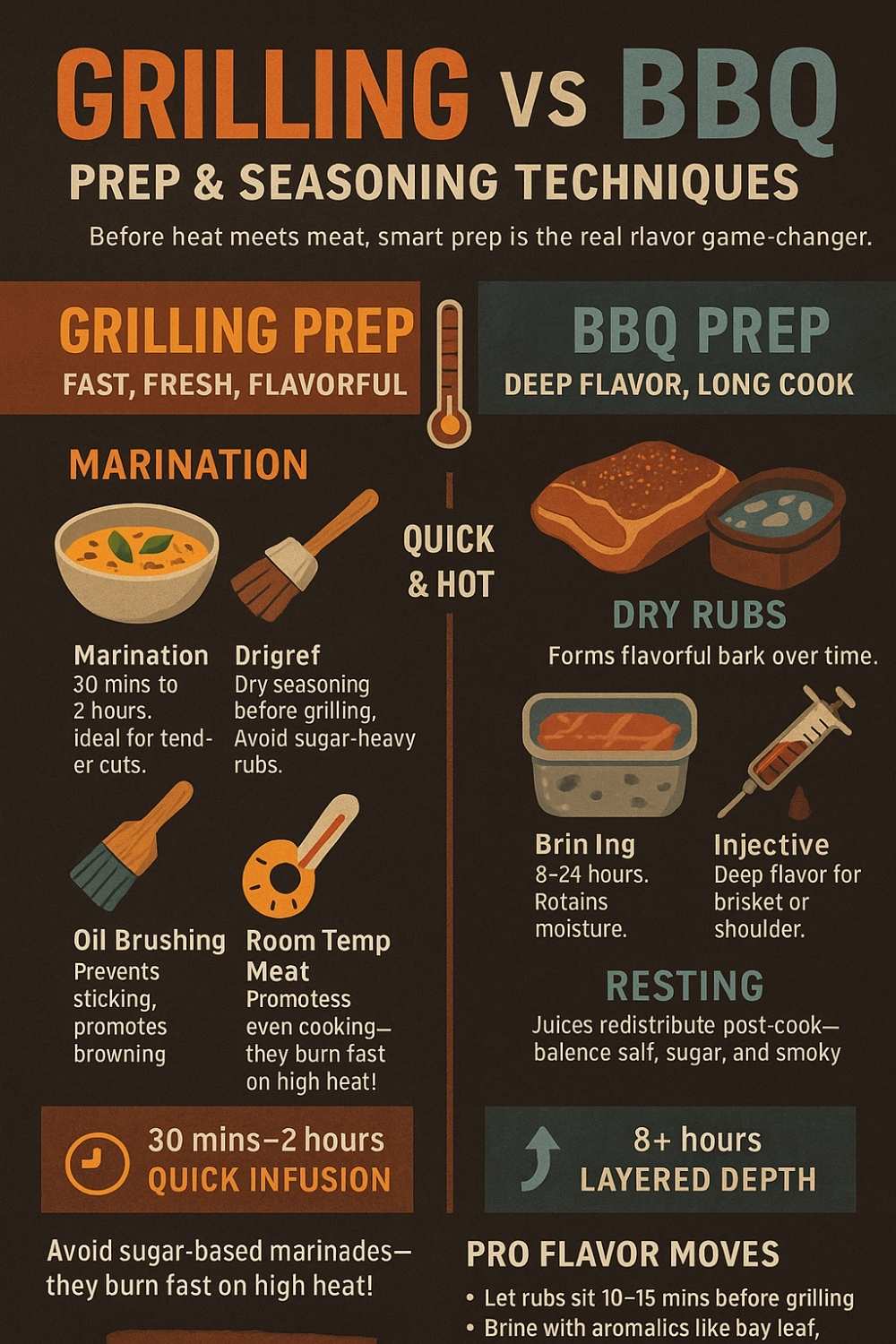
Because BBQ is a slow transformation, seasoning is often bold, with multiple steps applied throughout the cook.
Regional & Cultural Differences
The grilling vs. BBQ debate isn’t just technical—it’s cultural. Around the world, the meaning and method of “barbecue” can vary dramatically.
🌎 In the United States: BBQ is a Culinary Artform
In the U.S., BBQ refers specifically to low-and-slow cooking with smoke. It’s deeply regional, with distinct styles across the country:
| Region | Meat Focus | Sauce Style |
|---|---|---|
| Texas | Brisket, sausage | Minimal or peppery |
| Carolina | Pulled pork | Vinegar-based (East), mustard (South) |
| Kansas City | Ribs, burnt ends | Sweet, tomato-molasses |
| Memphis | Pork ribs | Dry rub or light sauce |
Each style has its own traditions, wood preferences, and spice philosophies.
🇬🇧 UK, Australia & Beyond: BBQ = Grilling
Outside the U.S., “barbecue” often simply means grilling outdoors. In the UK or Australia, a “barbie” might involve steaks, sausages, or veggies cooked quickly over a flame. Low-and-slow BBQ exists but isn’t as culturally dominant.
👨👩👧👦 Cultural Rituals
In many places, BBQ is more than a meal—it’s an event. Whether it’s American tailgates, Brazilian churrasco, Korean BBQ, or Japanese yakitori, each region brings its own tools, flavors, and communal traditions to the table.
Health & Safety Considerations
While grilling and BBQ can both produce delicious meals, they also come with unique health and safety concerns. Understanding and managing these risks ensures a safer and healthier cooking experience.
⚠️ Grilling Risks
The high heat and open flames of grilling can create carcinogenic compounds like HCAs (heterocyclic amines) and PAHs (polycyclic aromatic hydrocarbons), especially when fat drips onto flames and creates smoke.
Tips to reduce grilling risks:
- Trim excess fat to limit flare-ups.
- Avoid over-charring or burning meat.
- Flip frequently to cook evenly.
- Use a meat thermometer to avoid undercooked food.
🛑 BBQ Safety
BBQ cooking presents different challenges—chiefly food safety and temperature management over long cooks.
BBQ safety tips:
- Always use a thermometer to monitor internal meat temps.
- Keep meats out of the “danger zone” (40–140°F) before cooking.
- Use separate tools for raw and cooked meat.
- Regularly clean smokers and remove ash buildup.
🥦 Healthier BBQ/Grill Choices
Want to keep it tasty and heart-friendly?
- Choose leaner cuts (skinless chicken, fish, sirloin).
- Load up on grilled vegetables.
- Limit sugary sauces—add them at the end or on the side.
- Incorporate whole grains or legumes as sides.
Common Misconceptions
Despite their clear differences, grilling and BBQ are often confused—especially in casual conversation, advertising, or even restaurant menus. These misconceptions can cause culinary expectations to fall flat.
❓“BBQ” Is Just Another Word for Grilling
In many households, especially outside the southern U.S., “barbecue” is often used to describe a cookout involving hot dogs, burgers, or kebabs. Technically, that’s grilling, not BBQ.
Why the confusion?
- The term “BBQ” has become a cultural catchall for any outdoor cooking.
- Media and marketing blur definitions—“BBQ-flavored” chips have never seen a smoker.
- Fast food and casual chains market grilled foods as barbecue for flavor appeal.
🍖 Restaurant Shortcuts
Many restaurants offer “BBQ” dishes that are actually baked, grilled, or roasted, then slathered in BBQ sauce. True barbecue, involving smoke and slow heat, is far more labor-intensive.
Understanding the distinction helps set accurate expectations and improves your culinary vocabulary—whether you’re ordering, cooking, or educating others.
Hybrid Techniques
As outdoor cooking evolves, more people are blending grilling and BBQ to create hybrid methods that maximize convenience and flavor. These techniques offer flexibility for those without dedicated smokers or limited time.

🔄 Indirect Grilling
A method where food is placed away from direct flames, using a two-zone fire (one side hot, one cool). With the lid closed, this creates an oven-like environment—perfect for larger cuts like whole chickens or roasts.
Benefits:
- Cooks thicker foods evenly
- Adds a touch of smokiness
- Less risk of flare-ups
🔁 Reverse Searing
This technique combines both methods:
- Smoke or slow-cook the meat until it’s nearly done.
- Sear it on high heat for a crusty finish.
Popular for:
- Steaks
- Tomahawk chops
- Thick-cut pork
💡 Gas Grill Smoking Hacks
If you only have a gas grill, you can mimic BBQ by:
- Using a smoker box with wood chips
- Keeping one burner on low with the lid closed
- Adding a drip pan and water tray for moisture
Hybrid cooking opens the door to creative combinations, even with basic gear.
Cleaning & Maintenance Tips
Proper maintenance not only extends the life of your equipment but also ensures better-tasting, safer food.
🧼 Grilling Cleanup
- Brush grates after each session to remove charred residue.
- Empty grease trays regularly to avoid flare-ups.
- Deep-clean grates with vinegar or grill cleaner monthly.
- Check gas lines and burners for blockages.
🧹 BBQ Maintenance
- Ash removal: Essential for airflow and safety in charcoal smokers.
- Clean smoke buildup on lids and vents every few uses.
- Use mild soapy water to wipe down surfaces, avoiding harsh chemicals.
- Inspect for rust or mold, especially after off-season storage.
Seasonal deep cleans and regular touch-ups improve performance and flavor—your food will thank you.
Choosing Your Method
With all the differences and options explored, how do you decide whether to grill or BBQ? It comes down to time, taste, tools, and the type of food you’re preparing.
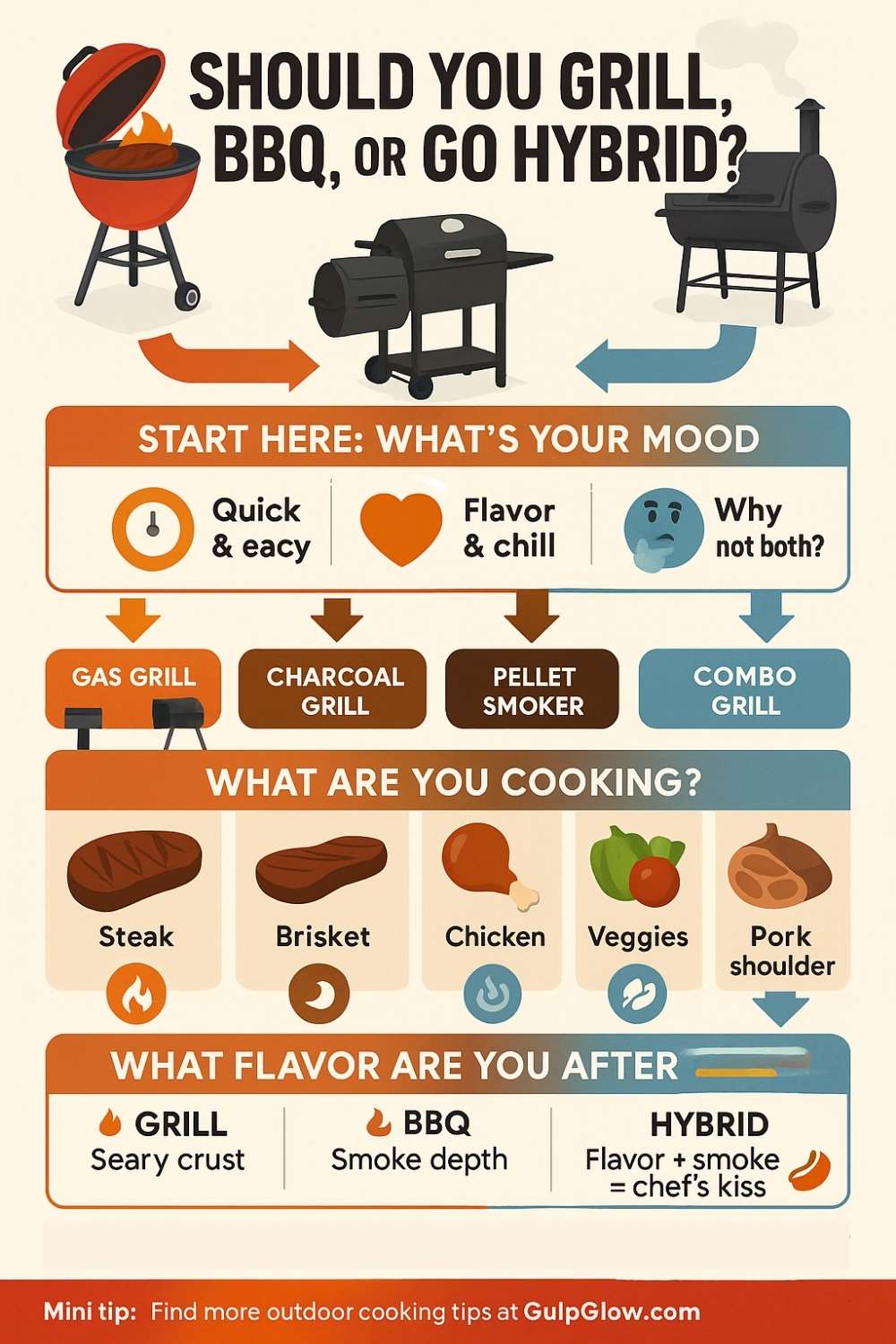
⏱️ Time Available
- Grill when you have 30 minutes or less and want something quick.
- BBQ when you have 4+ hours and can commit to low-and-slow cooking.
🍽️ Desired Flavor & Texture
- Choose grilling for a seared, smoky exterior and juicy interior.
- Opt for BBQ if you want melt-in-your-mouth texture and bold smoke flavor.
🔧 Your Equipment
- Only have a gas or charcoal grill? You can grill or use indirect methods.
- Have a smoker or pellet grill? You’re set for BBQ.
🧠 Experience Level
- Grilling is more beginner-friendly.
- BBQ requires more monitoring and skill—but is incredibly rewarding.
Final Tip:
If you’re hosting a big crowd or celebrating a special occasion, go for BBQ. If you’re cooking after work on a weeknight, stick with the grill. Or try a hybrid technique for the best of both worlds.

